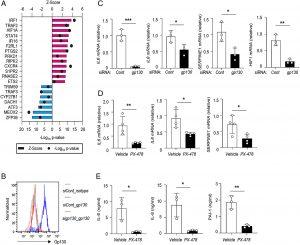A key player in the cytokine storm is Interleukin-6 (IL-6), which contributes to inflammation and tissue damage. IL-6 exerts its effects by binding to IL-6 receptors on cells, instructing them to promote inflammation. Blocking the IL-6 signal can alleviate inflammation in cytokine release syndrome (CRS); however, this approach often comes with long-lasting side effects.
Cytokines play a crucial role in the body’s defence against bacteria and viruses, as well as in regulating inflammation. Maintaining a balanced cytokine level is essential for a healthy immune system. However, this balance can be disrupted if the immune system reacts excessively, leading to a cytokine storm, which involves an overproduction of cytokines and results in severe, life-threatening inflammation.
In a recent study, researchers identified a method to block IL-6 signals with minimized side effects (Figure 1). They utilized an antibody that temporarily blocked the IL-6 receptor, providing a short-term interruption to the inflammatory signal. This brief intervention proved sufficient to protect tissues from damage caused by cytokine storms triggered by conditions such as sepsis or severe burns.

Figure 1: Endothelial gp130–HIF1α signaling mediates proinflammatory responses and PAI-1 production. (A) Gene expression of HUVECs induced by LPS+sIL-6R stimulation assessed by RNA-seq. Upstream regulator analysis of genes upregulated in HUVECs under LPS+sIL-6R stimulation. All datasets were examined by Ingenuity Pathway Analysis (Qiagen Bioinformatics). (B) Flow cytometry analysis of gp130 expression after siRNA transfection. (C) Cells were treated with si-IL6ST for 48 h following combined stimulation, and the indicated gene expressions were analyzed by quantitative real-time PCR (qRT-PCR). (D and E) Cells were pretreated with PX-478 (80 μM) for 4 h followed by LPS+sIL-6R stimulation for 24 h, and IL-6, IL-8, and PAI-1 expression levels were analyzed by qRT-PCR (D) and ELISA (E). *P < 0.05, **P < 0.01, ***P < 0.005. P-values were determined using unpaired, two-tailed Student’s t tests. Data are representative of three (B, D, and E) independent experimental replicates and are presented as means ± SD.
The findings suggest that an IL-6 receptor antibody with a short half-life could be an effective treatment for CRS, preventing vascular damage and simultaneously reducing side effects associated with prolonged IL-6 blockade. The researchers observed that blocking the IL-6R–HIF1α signal enhanced the strength of vascular endothelial cells, improving vessel integrity and preventing inflammation caused by CRS.
Journal article: Kang, S., et al., 2023. Gp130–HIF1α axis–induced vascular damage is prevented by the short-term inhibition of IL-6 receptor signaling. Proceedings of the National Academy of Sciences.
Summary by Stefan Botha










